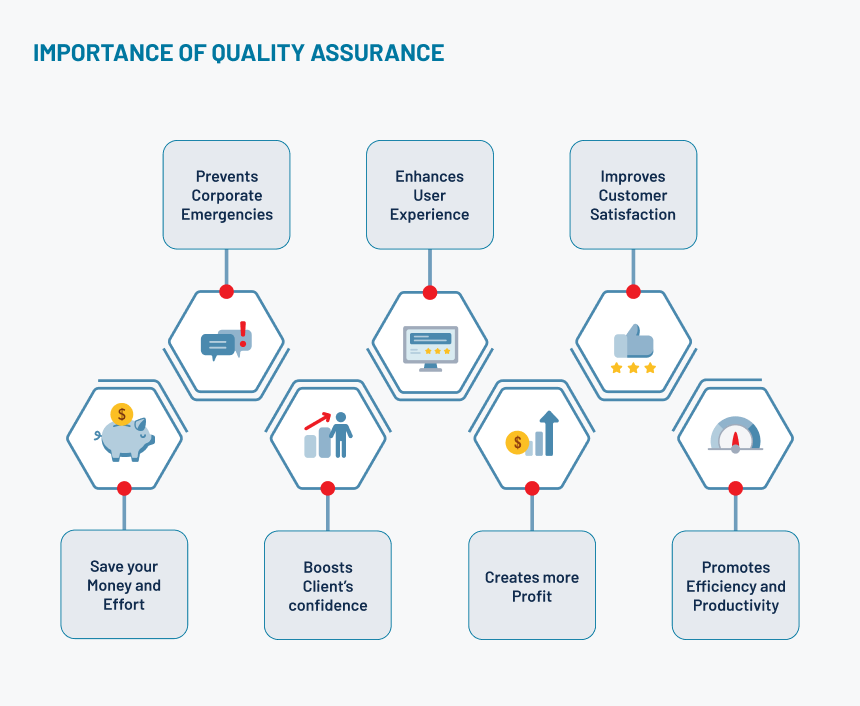Software Excellence: Introduction to Quality Assurance, Testing and Objectives
In the dynamic world of software development, Quality Assurance (QA) stands as a cornerstone, ensuring that products not only meet customer expectations but also uphold the highest standards of reliability and performance. This article explores the role of QA in software development, emphasizing its importance in building trust and customer loyalty – from detecting and preventing bugs to enhancing usability and performance.
Importance of quality assurance
Quality assurance (QA) is a crucial aspect of any organization’s operations, ensuring that products, services, and processes meet established standards and customer expectations. Quality assurance acts as a guiding force for companies, helping them create products and services that match with what customers are looking for.
The end result? Laying the foundation for trust and customer loyalty. Imagine it as a carefully crafted playbook—standards and procedures that act as guardians, making sure any potential hiccups in the products are caught and addressed before they even become noticeable. It’s like having a reliable ally ensuring that everything runs smoothly, guaranteeing customers receive nothing but the best.

Advantages of Quality Assurance
Testing and objectives
Testing is a process of all life cycle activities, both static and dynamic, concerned with planning, preparation and evaluation of software products and related work products to determine that they satisfy specified requirements, to demonstrate that they are fit for purpose and to detect defects accordingly.

Quality Assurance – Bug Detection
Objectives of testing is to cover the following aspects:
1. Bug detection:
Testing aims to detect defects or bugs in the software. By executing test cases and scenarios, testers actively search for errors, inconsistencies, or unexpected behavior in the software. Identifying bugs early in the development cycle allows for timely resolution, reducing the risk of these issues reaching end users.
2. Bug prevention:
Testing also contributes to bug prevention by uncovering potential issues before they occur. Through thorough testing, developers and testers can identify areas of weakness or vulnerability in the software and take proactive measures to address them. By identifying and fixing these issues proactively, the likelihood of bugs surfacing in the future is reduced.
3. Ensuring quality of software/product:
One of the primary objectives of testing is to ensure the overall quality of the software or product. This involves assessing whether the software meets the defined quality standards, including functional requirements, performance criteria, and usability expectations. Testing helps validate that the software functions correctly and meets the desired level of quality and reliability.
4. Increasing customer satisfaction:
Testing contributes to customer satisfaction by ensuring that the software meets or exceeds customer expectations. By identifying and resolving bugs, improving performance and enhancing usability, testing helps create a more stable and user friendly software experience. This, in turn, leads to increased customer satisfaction and a positive perception of the software or product.
5. Improve security, usability, and performance:
Testing plays a crucial role in identifying and addressing security vulnerabilities, usability issues, and performance bottlenecks. Security testing helps identify and mitigate potential risks and vulnerabilities in the software, safeguarding sensitive data and protecting against potential attacks. Usability testing ensures that the software is intuitive, easy to navigate, and meets user expectations. Performance testing helps assess and optimize the software’s speed, responsiveness, and scalability, ensuring it performs well under various conditions.
6. Reduce cost:
Effective testing can contribute to cost reduction in several ways. By detecting and resolving bugs early, testing helps prevent costly rework or the need for extensive bug fixing later in the development process. Additionally, testing helps identify areas for optimization and efficiency improvement, leading to more streamlined processes and reduced resource requirements.
Conclusion
In conclusion, testing stands as a critical process integral to the entire life cycle of software development, encompassing both static and dynamic activities. The versatile objectives of testing are central to ensuring the robustness and reliability of software products. From bug detection, where testers thoroughly uncover defects through the execution of test cases, to bug prevention by proactively addressing potential vulnerabilities, testing serves as a proactive shield against software issues.

We do it with passion and dedication.
CONSENT TO PERSONAL DATA PROCESSING
I hereby acknowledge and agree with the processing of personal data, which I submit to owner and controller Solviks, programske rešitve in poslovno svetovanje, d.o.o. ((ang. Solviks, software solutions and business consulting, d.o.o) Počehova 59i, 2000 Maribor, Slovenia, e-mail: info@solve-x.net) on the Website.
I hereby acknowledge and agree that the personal data provided is processed for the following purposes:
- marketing purposes relating to offers of products and services;
- sending information about products, services and other activities.
Solviks, d.o.o. is processing name, surname, e-mail.
The legal basis for the processing of personal data is the consent of individual under Article 6(1) of General Data Protection Regulation – GDPR.
I hereby acknowledge that the personal data which I submit will be processed to the extent necessary to achieve the above-mentioned purposes.
I hereby represent that I have been informed about my right to:
- withdraw my consent to personal data processing at any time- GDPR, Article 7;
- right to be informed- GDPR; Article 13;
- obtain access to the personal data held – GDPR, Article 15;
- incorrect, inaccurate or incomplete personal data to be corrected – GDPR, Article 16;
- request that personal data be erased when it is no longer needed or if processing is unlawful – GDPR, Article 17;
- request the restriction or suppression of personal data – GDPR, Article 18;
- receive personal data in a machine-readable format (data in a data format that can be automatically read and processed by a computer) and sent it to another controller – GDPR, Article 20);
- object to the processing of personal data in specific cases – GDPR, Article 21;
- request that decisions based on automated processing concerning or significantly affecting a person and it is based on personal data are made by natural persons, not only by completers – GDPR, Article 22 (automated is only a process of inviting members to participate in surveys);
- object to the transfer of my personal data.
I hereby acknowledge that I can submit a complaint to the Information Commissioner in Slovenia (Dunajska cesta 22, 1000 Ljubljana, e-mail: gp.ip@ip-rs.si, phone: 012309730, Website: www.ip-rs.si).
I hereby acknowledge that personal data requests and any other questions about personal data can be sent to an e-mail: vesna.brlic@solve-x.net or info@solve-x.net.
I hereby represent that I have carefully read all the above provisions and do voluntarily and unequivocally agree with them.
